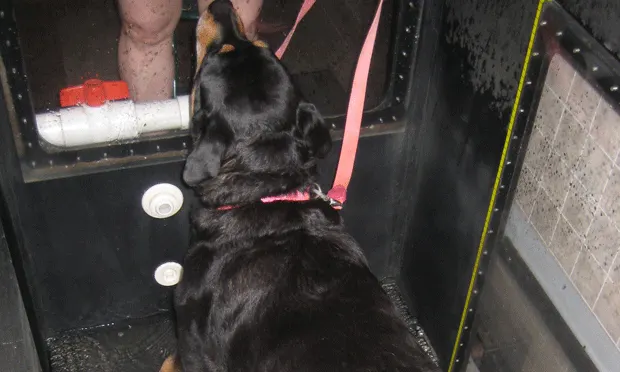Physical Rehabilitation for Conditioning & Weight Loss

Luna, a 4-year-old spayed female Rottweiler, was referred for physical rehabilitation to improve conditioning and aid in weight loss.
History. Luna’s owner recently enrolled Luna in agility classes and noticed that she was having difficulty reaching the 20-inch jump height required for her breed. The owner also reported intermittent episodes of lameness.
Luna’s primary veterinarian obtained radiographs of the dog’s hips and elbows that revealed minor hip dysplasia but no other abnormalities. Results from a complete blood count and serum biochemical profile were within normal limits and the referring veterinarian excluded musculoskeletal disease (including soft tissue disease) from the differential diagnosis.
Luna was being fed 2 cups of a commercial high-protein food twice daily. In addition, each meal included 0.5 cup fresh string beans and 0.5 cup ground beef. The owner administered a commercial brand of glucosamine once daily. Agility training sessions were held 3 to 4 times weekly, during which ham steak was fed as a treat.
Physical Examination. Luna’s body weight was 51.8 kg (114 lb) with a body condition score of 7/9. A full body assessment was performed to determine range of motion and girth. Range of motion of the bilateral forelimbs and hindlimbs was similar, and there was no pain or discomfort on any passive range of motion.
Chest girth (T3) was 58 cm, waist girth (L2) was 48 cm, and thigh circumference (70%) was 32 cm on the left and 33 cm on the right. A static force plate analysis indicated 62% weight-bearing equally on the bilateral forelimbs and 38% weight-bearing on the hindlimbs (20% on the left and 18% on the right).
Treatment Strategy. Luna’s diet was altered with the assistance of the primary veterinarian. The high-protein diet was maintained to promote weight loss while preserving lean muscle mass,1 but reduced to 1 cup of food twice daily plus 0.25 cup of a lean protein twice daily. In addition, the green beans were eliminated from Luna’s meals and utilized for treats instead of ham steaks.
The owner was worried that Luna would be hungry during the day; however, the owner was motivated to comply with diet recommendations because she wanted Luna to return to agility training and reduce her obesity-related health risks.
Ask Yourself...
Which of the following is an appropriate initial rehabilitation strategy for this dog?A. Increased free play in the backyardB. Land treadmill routineC. Underwater treadmill routineD. Exercise ball routine
Correct Answer:C. Underwater treadmill routine
Walking Program. At the time of the initial evaluation, Luna’s daily exercise consisted of playing in the backyard and agility classes. A walking program was prescribed for exercise and weight loss, beginning with a 15-minute walk twice daily. Every 4 days, the walking time was increased by 3 to 5 minutes. Backyard exercise was encouraged but not considered part of the formal program. In addition, Luna continued to compete in agility once a month and participate in class once a week.
Underwater Treadmill Sessions. Twice weekly underwater treadmill sessions were recommended. The underwater treadmill was chosen instead of a land treadmill because the buoyancy of water decreases weight and stress on joints. In addition, the hydrostatic pressure aids in reducing swelling and provides a beneficial environment for working with painful joints.2 Hydrostatic pressure has also been demonstrated to decrease pain perception.3
For Luna, the water level in the treadmill was filled just below the greater trochanter, which provided resistance but reduced any stress on the stifles and elbows.4 Water resistance aids in strengthening the musculoskeletal system and improves cardiovascular resistance. The surface tension of the water allowed Luna to move more freely than she could on land.
Luna’s heart rate was monitored while she was in the water, with the goal of maintaining a rate of 125 bpm; her resting rate was 96 bpm.

Filling the underwater treadmill with water
Luna walking in the treadmill with the water at the level of the greater trochanter
Luna’s sessions progressed as follows:
Weeks 1 & 2: 20-minute sessions in the underwater treadmill, broken into two 10-minute working periods at speeds ranging from 2 to 2.5 mph.
Week 3: 30-minute sessions, broken into two 15-minute working periods at speeds ranging from 2.5 to 3 mph.
Week 4: 40-minute sessions, broken into two 20-minute working periods at 3 mph.
Weeks 5 to 10: Luna continued with 2 to 3 weekly sessions for 10 weeks. By week 8, she was walking for 40-minute working periods at 3 mph.
Results. At the conclusion of 10 weeks, Luna’s working heart rate at 3 mph was 110 bpm. At 12 weeks, her weight was reduced to 41.4 kg (91 lb). Chest girth was 52 cm, waist was 43 cm, and thigh circumference was 33 cm on the right and 34 cm on the left.
The owner reported that Luna had increased energy, no episodes of lameness with agility exercises, and improved attention during training. As the rehabilitation program progressed, land treadmill and exercise ball routines were added to Luna’s program. Her owner also took her swimming in a nearby lake.
Take-Home Message
Weight loss is difficult to accomplish in dogs, and many owners are overwhelmed when faced with the task of changing their dog’s diet and exercise routine. Veterinary clinics and rehabilitation centers can improve their services by offering weight loss programs, including water walking, underwater treadmills, and other exercise options.
PHYSICAL REHABILITATION FOR CONDITIONING & WEIGHT LOSS • Deborah Gross Saunders
References
Increased dietary protein spares lean body mass during weight loss in dogs. Hannah SS, Laflamme DP. J Vet Int Med 12:224, 1998.2. Percentage of normal weight bearing during immersion at various depths in dogs. Levine D, Tragauer V, Millis DL. 2nd Int Symp Rehabil Phys Ther Vet Med Proc, 2002, p 189.3. Aquatic Physical Therapy. Bates A, Hanson N—Philadelphia: WB Saunders, 1996.4. Aquatic therapy: Therapeutic treatment for today’s patient. Johns KM. Phys Ther Prod May:24-25, 1993.